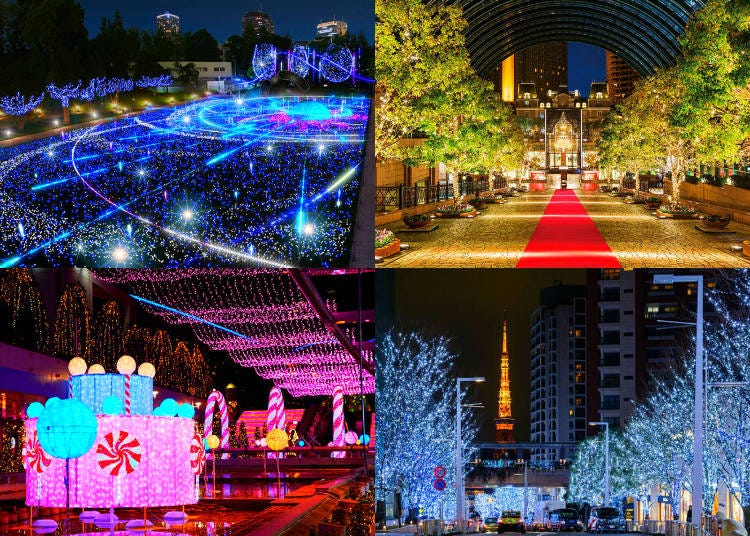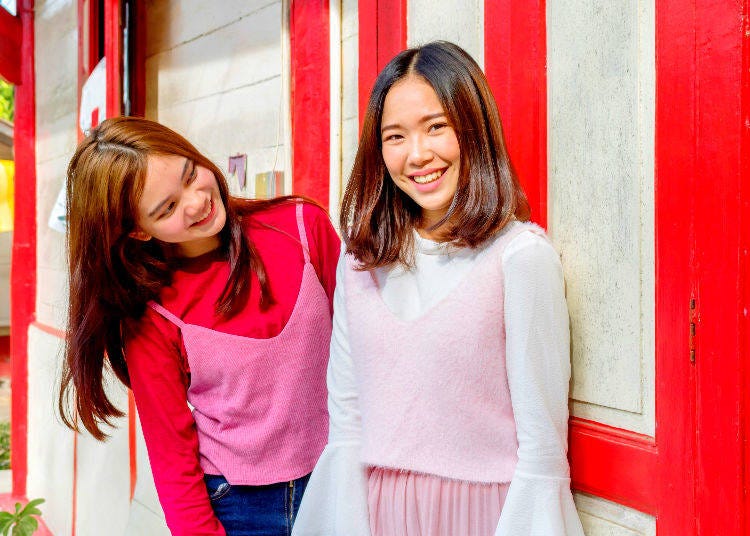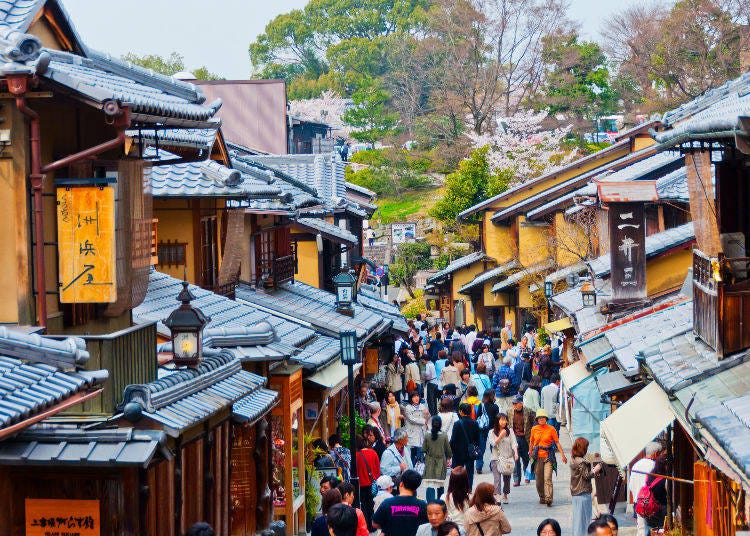
From obligatory chocolate on Valentine's Day to fried chicken on Christmas - Some events we might think we know very well are celebrated pretty differently in the Land of the Rising Sun. Of course, every country is somewhat influenced by the next, and we're constantly changing and adapting to the newest changes, but how have those changes come to pass in Japan?
From food to IT, Japan has the unique habit of absorbing and transforming culture from abroad, with a fairly long history of evolving an original culture to turn it into something entirely unique to Japan. Of course, that's not only true of food and IT, but of adapting Western customs that are known throughout the world, such as Halloween, Christmas, Valentine’s Day, and quite a few others!
- Table of Contents
-
- 1. Japan’s Halloween is Just a Giant Cosplay Event!
- 2. Christmas in Japan is a Couple’s Event Rather than a Family Event?!
- New Year is Highly Valued: Celebrating New Year’s Day Quietly with Family
- 3. Japanese Valentine’s Day Overthrows Global Customs
- 4. The Original Meaning Hidden in Japan’s “Labor Thanksgiving Day”
- Extra: Global Culture that’s the Same in Japan!
1. Japan’s Halloween is Just a Giant Cosplay Event!

Originally, Halloween has its roots in Gaelic and Welsh culture. People celebrated a harvest festival to honor Samhain, the Celtic god of death, and to welcome both winter and the new year. In Japan, Halloween wasn’t known at all until the early 2010s, but in recent years, October lines the stores with ornamental pumpkins and cute ghost-themed characters, making it a generally enjoyable event.
On October 31, the day of Halloween, the news shows young people merrymaking in flamboyant costumes.
However, few Japanese people understand exactly what kind of event Halloween was originally. Many think that it’s simply a costume parade or cosplay event. But perhaps that's reflective of a wider global trend anyway...?
Japanese Halloween has a Commercial Background?!

One characteristic of Japanese Halloween is that it was brought in by companies for commercial reasons. It’s said that Halloween in America is similarly for-profit - Japanese companies adopted the “party elements only” and won over the Japanese people. While folks don’t necessarily understand what kind of festival Halloween is, they are entranced by the peculiar world of Halloween that unfolds at trendsetter spots such as Tokyo Disneyland, entirely fascinated by candy adorned with adorable Halloween-only characters and the joy of the rather unusual costumes.
Perhaps it was only natural that in Japan, where manga and anime culture has become a dominant aspect of pop culture, Halloween and its cuteness of monsters and ghosts such as Jack-o'-lantern and extraordinary feeling of walking around town in grand disguise would be accepted by the Japanese people.
Do Japanese Children go Trick-or-Treating as well?

In the United States and indeed elsewhere, children disguise themselves as ghosts, vampires, and so on to enjoy “Trick or Treating,” which you're likely aware is the act of walking around the neighborhood or parties and asking for sweets. Even in Japan, mothers with small children can now be seen planning a gathering to have the little ones go trick-or-treating at the houses of friends.
In urban areas where neighborhood associations have become scarce, going from house to house to ask for sweets can be difficult. However, such Halloween events also have the effect of revitalizing these waning local bonds and associations with neighborhood gatherings and the likes.
And Yet, Japan’s Quirky Version of Halloween Seems to Transcend Halloween’s Concept

In Japan, if anything, the merrymaking of adults disguised as characters from all kinds of worlds, including anime and video games, has been established as the “Japanese Halloween.”
New York has its own large-scale costume parade, but it is usually more known for its spooky and perhaps generic monsters. Another massive Halloween Festival is Londonderry’s Derry Halloween in Ireland, the birthplace of Halloween, but even there, costumes of demons, ghosts, and other ghastly creatures are the norm.
Japan is not the only country that enjoys the cuter costume aspect of Halloween, but it is probably not an exaggeration to say that Japan is one of the only countries with a cosplay-centered “anything goes” approach. Halloween in Japan, which has evolved into a massive cosplay event with an almost competitive element for the most innovative costumes is also attracting attention from Non-Japanese people.
These days, “Japanese Halloween” has become a hot topic among many young people. Some even come to Japan specifically to join Halloween in Shibuya.
2. Christmas in Japan is a Couple’s Event Rather than a Family Event?!
All over the world, it is common to spend Christmas with one’s family, but this common practice does not apply to Japan. Here, Christmas means spending a romantic day with your crush or partner.
Is Japanese Christmas Lonely if You’re Single?

In Japan, there are not many people who celebrate Christmas in a religious way. Christmas in Japan is not an event spent with family, friends, and spouses, having a nice meal together and exchanging gifts. Japan’s unique characteristic is “spending Christmas as a couple.”
In the 80s, Japanese magazines started the trend of “spending Christmas with your lover at a city hotel,” and there were plenty of commercials showing a couple dating on Christmas Eve. It is said that the trend of “Christmas is for couples” was established after that. Certainly, fairytale-like illuminations and atmospheric, sentimental Christmas songs do create a romantic atmosphere.
Christmas is Supposed to be Festive Family Time, but in Japan...?

In Europe and the United States, Christmas is an important day that is spent with one’s family and a lot of people attend the Midnight Mass or other Christmas masses. If anything, somewhat similar to this is New Year’s Day in Japan on which people return home to spend a relaxed time with their family.
On the other hand, Christmas in Japan is pretty lively. There are no Christmas holidays, so it’s not uncommon to see office workers stopping for one or more drinks with coworkers after work and going home rather drunk afterward. Walking around the city on Christmas Eve in Japan usually means seeing happy couples and drunk folk that are painting the town red.
What’s Japan’s Style of Eating Chicken and Shortcake on Christmas?!

Christmas in the West means doing one’s best to make great home-cooked food. Every family has their own classic Christmas dishes, such as turkey.
In Japan, however, commercial fried chicken joints such as Kentucky Fried Chicken see their sales explore during Christmas. A lot of non-Japanese people are surprised by Japanese people happily eating KFC – fast food! – on Christmas Eve.

Speaking of Japanese Christmas dishes, decorated cake is just as indispensable as bone-in chicken.
Outside of Japan, what kind of cake is enjoyed for Christmas varies by country. France eats Bûche de Noël (“Yule log”), Germany and the Netherlands eat sweet bread with nuts and raisins kneaded in the dough called Stollen, and the United Kingdom has its Christmas Pudding with plenty of dried fruit.
However, Christmas cake in Japan means short cake with plenty of whipped cream topped with strawberries, and sugar confectionery toppings in the shape of Santa Claus and his reindeer are also popular.
Does Japan Have no Christmas Card Tradition?

The West has a tradition of sending Christmas cards. While those cards are sold in Japan, they are only used to be attached to a gift. Japanese people instead send New Year’s cards and greetings, which is why there is no need to send Christmas cards. If you would like to send seasonal greetings to someone in Japan, it’s better to send a New Year’s card rather than a Christmas card.
New Year is Highly Valued: Celebrating New Year’s Day Quietly with Family

New Year’s is a highly celebrated event, no matter which country you look at. However, perhaps there are not many countries that cherish the family time around New Year’s as much as Japan. Even though ancient customs are on the wane in Japan, a lot of families celebrate New Year’s together quietly, making preparations to welcome the deities of New Year.
The Rapid Switch from Christmas to New Year is Unique in Japan!

Once Christmas is over, some Non-Japanese people are surely surprised by how rapidly the mood in Japan changes to anticipating New Year’s. Unlike in the West where it’s common to keep Christmas decorations up until Epiphany (Three Kings’ Day) on January 6, this shows how important New Year’s culture is in Japan.
Welcoming the New Year Quietly with Family in Japan

This is the opposite of the West, where high-spirited countdown parties with family and friends are the main New Year’s event. The custom of the entire family gathering under the kotatsu (heated table) and eating toshikoshi-soba (“longevity noodles”) while watching TV and waiting for midnight on New Year’s Eve is seen throughout Japan. People quietly wait for the old year changing to the new while listening to Buddhist temple bells ringing 108 times to symbolize and cleanse the 108 worldly desires of Buddhism and wish each other a Happy New Year with the phrase “akemashite omedetō gozaimasu” – that’s Japan’s way to welcome the new year.
Japanese New Year’s Holidays – a Precious, Long Vacation

In Japan, the first three days of the new year are also festive days to celebrate that oneself and one’s family got into the new year successfully and without harm. Japanese people are known to be hard workers, but even the busiest people tend to take a vacation for New Year’s. Especially New Year’s Day is an important date as it is the day to welcome the New Year’s deities, so the majority of people spent it with their family, quietly and festive.
What’s Otoshidama, the Thing Kids Look Forward to?

Otoshidama is a custom that goes back to sharing round rice cakes that were prepared for the New Year’s deities. For Japanese children, this is the most enjoyable part of welcoming the new year, as they’re given small envelopes filled with money.
Japan’s Unique “Lucky Bags” Get Bigger and Better Every Year

Fukubukuro (“lucky bags”) sold at department stores and other shops are also a Japanese New Year’s tradition. These lucky bags are bargain-priced bags filled with various items of one theme, such as clothes or miscellaneous goods. You can’t see what’s inside as you buy the bag, so it’s also seen as a trial of luck.

During that time, it’s common to see shops with long queues of people waiting to get a lucky bag. Recently, there as a lot of talk surrounding luxury lucky bags that feature jewelry, round-the-world cruises, or even apartment ownership.
3. Japanese Valentine’s Day Overthrows Global Customs

Valentine’s Day around the world is usually seen as men giving gifts to women, or perhaps both exchanging them with each other. But in Japan, the day is used by women to give chocolate to their crush and "confess their love."
Japanese Valentine’s Day: Women Confess Their Love

In the West, people exchange Valentine’s cards regardless of age or sex, and elsewhere you might see only the men giving presents and bouquets of roses to their partners.
In Japan, however, women confess their love by giving their crush chocolate. It’s said that this style of celebrating Valentine’s Day was created by a (successful!) sweets makers’ strategy.
What’s “Giri-Choco?” Giving “Duty Chocolate” to One’s Peers

Japanese Valentine’s Day features yet another unusual custom...
Women don’t only give chocolate to those they have genuine romantic feelings for, but also to their peers, such as colleagues at the workplace and other acquaintances. That is known as “giri-choco,” or “obligatory chocolate” that is given to express appreciation of that person in one’s daily life.
Seeing as giri-choco is fully established, female employees often gather money to buy and distribute chocolate to their male coworkers systematically. Also, Japanese girls and young women also exchange chocolate with one another as “tomo-choco (friendship chocolate)” – Japanese Valentine’s Day keeps finding new ways to surprise us!
There has been some debate online recently as to whether this is a custom worth continuing or not, but for now, it's still rather commonplace.
Returning the Valentine: Japan’s “White Day” Custom

On White Day, exactly a month later, men give gifts such as marshmallows or candy to the women they got Valentine’s chocolate from – it’s a custom that’s probably not very well known abroad. However, there’s not that one standard gift for White Day like chocolate is for Valentine’s (meaning you're likely to find a few lost-looking men in department stores around this time of year)!
4. The Original Meaning Hidden in Japan’s “Labor Thanksgiving Day”

November 23 is Labor Thanksgiving Day in Japan, a national holiday. It is generally about children expressing their gratitude towards their parents and the hard work that they do. However, it’s not as important as Thanksgiving Day in the United States and because Father’s and Mother’s Day are also occasions to thank one’s parents, it is merely a regular holiday for many Japanese people, unfortunately.
Is There a Day Like Thanksgiving Day in Japan?

It’s a well-known fact that the American Thanksgiving Day takes place on the last Thursday of November to celebrate the harvest of that year. Just like the aforementioned Halloween is based on an ancient Celtic harvest festival, most countries have some sort of special day or event to be grateful for the harvest. The rituals celebrating this harvest have been cherished for a long time, as it is vital to our survival. But Japan’s Labor Thanksgiving Day doesn’t quite seem to fall into that category.
Labor Thanksgiving Day Was Originally a Harvest Festival

Labor Thanksgiving Day was officially enacted on November 23 of 1948. Up until then, it was a harvest festival called “Niinamesai” in which people thanked the deities for the harvest and prayed for another abundant harvest for the following year. After the war, the name changed to Labor Thanksgiving Day, but even nowadays, rituals of the old harvest festival are carried out at shrines throughout the country.
Extra: Global Culture that’s the Same in Japan!
While Japan tends to shape culture from abroad in its own unique way, there are also some things that were adapted as they are.
Mother’s Day: Expressing Gratitude

The second Sunday of May is Mother’s Day, a day to express gratitude towards one’s mom. The day came to Japan from the United States around 1915. It seems that Australians gift chrysanthemum flowers, Italians give their moms azaleas, and blue jasmine is the standard Mother’s Day flower in Thailand, but in Japan, it’s the same as in the United States: red carnation. Whatever the type of flower is, though, the feelings expressed with them towards our moms are the same in any country.
Father’s Day: No Flowers in Japan

Father’s Day was created from the desire to also thank one’s dad on top of Mother’s Day. It seems to have come to Japan from the United States in the 1950s.
Roses are a symbol for Father’s Day in the United States, but Japan doesn’t have a staple gift like it has for Mother’s Day. Instead, children buy gifts such as neckties, belts, or anything that their dad might find useful for work. Very young children also often craft a “shoulder rub ticket” for their fathers and when they redeem it, the little ones do their best to massage their dad’s stiff shoulders. It’s a rather adorable custom. When it comes to expressing gratitude to one’s dad who toils endlessly for the family, it’s true all around the globe that the feelings behind the gift are far more important than the gift itself.
April Fools’ Day Exists in Japan as Well! But Maybe Weaker Than in the West...

April Fools’ Day is the one day of the year that makes lying perfectly acceptable. Even in Japan, people prank their friends at school and colleagues at work on April 1. In this modern age, social media has also brought forth some very elaborate prank posts. April Fools’ is known in Japan, both in name and in concept, but there are plenty of people who end up believing misinformation that stems from a prank, to a point where the people responsible for it have to apologize later on.
In the West, famous newspapers and TV stations can publish made-up articles or broadcast prank reports as if they were genuine, such as showcasing a “discovery of the century,” so in that regard Japan might still be a bit inexperienced.

As you’ve seen, Japan has put its own unique stamp on customs and cultures from the West, often making a big leap from the original thing. It is not an exaggeration to say that a custom’s original meaning is reduced, and it is born again as something new. One major characteristic is that events and customs are imported for commercial reasons. Japan boasts a lot of traditional events that have been passed down since ancient times, but don’t ignore “unique Japanese customs and events” that have their root overseas and have been rearranged in a uniquely Japanese style – enjoy both traditional and adapted culture! We promise you that Japan will show you things that you’re familiar with in a wholly different and exciting way.
written by yoko
main image; anothai thiansawang / shutterstock.com
*Prices and options mentioned are subject to change.
*Unless stated otherwise, all prices include tax.
Popular Tours & Activitiess
-
Ad

Discover the "Miraculous Forest" in the Heart of Tokyo: The Institute for Nature Study (9 Minutes from JR Meguro Station)
-

Strawberries, Style, and Tokyo’s Coolest Neighborhood: Winter Afternoon Tea in Kichijoji
by: Guest Contributor
-

This Winter, Godzilla Takes Over Haneda Airport
by: Guest Contributor
-

Japan’s Shinkansen Is About to Change Travel in an Unexpected Way
by: Guest Contributor
-

How to Get Don Quijote's Exclusive 2025-2026 Winter Gift (+Tax-Free Savings)
-

First Japan Cherry Blossom 2026 Forecast Announced! Here's When & Where to See Sakura in Japan
Inspiration for Accommodations
-

Enjoy Mt. Fuji from the Comfort of Your Room! Recommended Ryokan with Mt. Fuji View
-

Stay Near the Cherry Blossoms! Hotels for Cherry Blossom Viewing in Tokyo
-

Family-Friendly Hotels with Free Shuttle to Disneyland: Convenient Access for a Magical Stay
-

Top Ranked Hakone Hotels with Mt. Fuji View: Enjoy Stunning Scenery from Your Private Space
-

Convenient Tokyo Hotels with Airport Shuttle: Ideal for Families and Heavy Luggage
-

Stunning Tokyo Tower View Hotels: Enjoy Spectacular Scenery from Your Private Space
-

Convenient Asakusa Hotels with Kitchens: Ideal for Extended Family Visits
-

Experience Luxury: Hakone's 10 Best Five-Star Accommodations
-

Enjoy Mt. Fuji Autumn Leaves! Top Hotels Near the Popular Autumn Leaves Corridor
-

Experience Hakone Fall Foliage from Your Room with Stunning Views
-

We Tried Japan's $30 'Obligation Chocolate' For Valentine's Day - Would We Do It Again?
-

Get it at Tokyu Hands! Japan's Top 10 Emergency Goods to Take Home
-

Tokyo Tsukiji|Tsukiji Area Map & Sightseeing Information
-

11 Must-Visit Vintage Shops in Tokyo for a Perfect Treasure Hunt
by: Miyu Shimada
-

Recommendations From a Tokyo Beauty Concierge: Top 10 Low-Cost Cosmetics at Tokyu Hands!
-

The Best of Japan: 11 Major Cities Every Traveler Should Visit
- #best ramen tokyo
- #what to buy in ameyoko
- #what to bring to japan
- #new years in tokyo
- #best izakaya shinjuku
- #things to do tokyo
- #japanese nail trends
- #what to do in odaiba
- #onsen tattoo friendly tokyo
- #daiso
- #best sushi ginza
- #japanese convenience store snacks
- #best yakiniku shibuya
- #japanese fashion culture
- #best japanese soft drinks


















